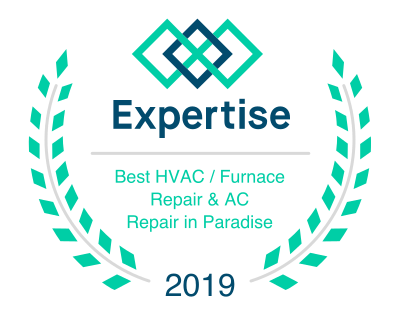If you’re like most people, your only interaction with your HVAC unit and its associated products like thermostats is turning it on and off. Much like a pump, it works to establish an airflow within your living environment, efficiently adjusting to your needs whether it be cooling during the hot Las Vegas summers or providing heat on cold winter nights.
It is, however, always good to have a basic understanding of how a residential heating and cooling system works. Not only will this knowledge help troubleshoot potential HVAC problems, it will also make it easier to communicate more effectively with the HVAC technician during installation or repair. A comprehensive understanding of how everything from the filter to the compressor works together can also help you maintain your HVAC unit according to differing temperatures and areas in your home. Here’s our complete guide to how a residential HVAC unit works.
The Different Parts of an HVAC Unit
HVAC stands for heating, ventilation, and air conditioning. It contains multiple component parts, including the vital heat pump. Most homes in Las Vegas have a central heating and cooling system, but many homeowners don’t fully understand how it works or is installed, leading to potentially inefficient usage.
There are four types of HVAC systems: split systems, packaged units, heat pumps, and ductless mini-split systems. Traditional split systems are comprised of indoor and outdoor units that are attached to an extensive ductwork system. This system runs through the house and circulates air through vents in each room. Packaged air conditioning systems and heat pumps are contained in one unit and ductless systems. As the name suggests, they don’t require ducts. All central air systems are controlled by the thermostat.
To gain a better understanding of how a central air system works, let’s take an in-depth look at the main parts that make up a residential HVAC system.
Condenser
The condenser, often the main ingredient of this complex machine, is located in the outdoor unit, where heat transfer takes place. The condenser is comprised of the compressor, condenser fan motor, coils, and control board. The cooling process begins when the refrigerant flows through the coils while the fan pulls in air. The incoming air blows over the coil, promoting heat dissipation.
Problems arising with the condenser unit can generally be traced back to the fan, motor, capacitor, dirty or bent condenser coils, or potentially damaged fan blades. When the condenser fan doesn’t work, the refrigerant in the coils can’t be cooled, which negatively affects the overall system’s performance and leaves you with an AC unit that isn’t blowing cold air. This situation is a clear sign that there could be a problem with the condensing unit.
The role of the compressor in your HVAC unit
At the heart of the condensing unit, the compressor is dubbed the ‘heart’ of the air conditioner as it is responsible for pumping refrigerant through the system, just like a real heart pumps blood. Without the refrigerant, your air conditioner wouldn’t be able to produce cold air, similar to how a pump is needed to maintain proper airflow.
Driven by a motor, the compressor goes through lots of wear and tear due to continuous use. Regular inspections and cleaning of the outdoor unit are essential as dirt and grime build-up can put extra strain on the compressor and motor, leading to potential malfunctioning.
As one of the costliest parts to replace, avoiding unnecessary breakdowns of the compressor with regular maintenance is an essential step in managing your HVAC system.
Evaporator Coil
Inside your home, the evaporator coil is mounted in or above the air handling unit. The air handler and furnace are often located in the same areas inside your property for optimal efficiency.
Lastly, copper pipes carry refrigerant from the condensing unit outside to the evaporator inside, effectively controlling the temperatures within your home. This process, driven by the compressor and heat pump, is the cornerstone of an efficient HVAC system.
This is where the cool air you feel in your home comes from, generated by your efficient air conditioning unit. By the time the refrigerant gas reaches the evaporator, after passing through a variety of different equipment, it has changed into a cool liquid. This process is influenced greatly by the level of humidity in your home.
Warm air passes over the cold evaporator coils that vaporize the refrigerant liquid and turns it back into a cool gas that absorbs heat from the air and cools it. This cool air is then distributed through the ducts and out through the vents into your home, literally making a state of difference in the temperature. The heat collected from inside is absorbed into the coils as a part of the circulation process. This allows the air conditioning unit to maintain energy efficiency.
The role of the blower motor in your HVAC unit
The blower motor, maintained by a competent HVAC contractor, is part of the evaporator coils. If the air conditioner runs but no cold air is coming from it, it usually indicates a faulty blower motor. Contrary to what many believe, air conditioners don’t produce cold air. They simply transfer heat from one area to another, and the blower is the crucial component that directs this heat transfer.
The blower fan sucks in warm air passes it over the evaporator coils where it cools and returns the cooled air to the room. It operates like a well-oiled machine – this could even be a literal statement if your HVAC unit uses fuel in its operation. When the blower malfunctions, no air circulates through the HVAC unit. This can lead to serious problems, like the evaporator coils freezing over. If this happens to your system, shut off the AC and call a technician who will check and repair the blower.
Furnace
The furnace, equipment that requires adequate level of maintenance, is typically located in a basement or attic. The most common type of furnace in most central heating systems is natural or propane-powered gas furnaces.
Both the air conditioner and furnace connects to the home’s ductwork. A gas furnace is made up of the following parts:
- A gas valve
- Ignition switch and burner
- Heat exchanger
- Blower
- Exhaust outlet
Your home HVAC Unit: Understanding The Thermostat
The thermostat is the “brain” of the HVAC. It senses temperature and tells the AC or furnace to start running when the temperature of the air in the home no longer matches the temperature set on the thermostat. Once the desired temperature is reached, the difference prompts the thermostat to turn off the AC or furnace. When the temperature drops or increases, the thermostat will start another cycle.
How a Residential Air Conditioner Or HVAC Unit Works
Air conditioners work on a simple physics principle of liquid that expands into gas to pull heat from its surroundings. Evaporation aides the cooling process. This explanation only gives you a taste of the variety of mechanisms and principles at play. Let’s explain this in more detail.
Your air conditioner uses refrigerant gas as a key ingredient. Refrigerant is crucial in turning warm air into cold air. It runs through the AC condenser coil located in the outdoor unit to the evaporator coil in the unit inside the house.
When you turn on the air conditioner, low-pressure refrigerant gas starts the cooling cycle in the compressor where it is “compressed” into a hot, high-pressure gas. This pressurized gas flows through the condenser coils where it is “condensed” into a high-pressure liquid. At the same time, the condenser fan blows over the coils and removes excess heat out into the air, highlighting the energy efficiency of the process.
The hot liquid then passes through an expansion valve where the pressure is lowered. This low-pressure liquid flows into the evaporator coil where it cools and changes back into a low-pressure vaporized gas. As it does this, it absorbs heat from the surrounding air, leaving behind the cool air that is blown through the ductwork and into your home. The heat absorbed from the house’s air is carried back to the compressor where it is expelled to the outside, and the whole cycle starts again.
How a Furnace Works
There are three types of fuel run furnaces: gas, oil, and electric. Each type varies in its working mechanism, cost, and level of energy efficiency. For better maintenance and service of your HVAC facility, always keep in touch with a certified HVAC contractor.Gas and oil furnaces utilize fossil fuels like natural gas, propane, or oil to generate heat, while electric furnaces operate solely on electricity. In varied climates such as Las Vegas, most homes feature a gas furnace, an effective heating unit that connects conveniently to the city’s natural gas lines.
A gas furnace functions in this way:
- The gas valve is linked to the control board which links to the thermostat. When you turn the furnace on, the thermostat communicates with the control board and activates the gas valve. The valve opens just long enough to release enough gas to ignite the burner.
- The thermostat continues to sense temperature changes in the home and “instructs” the control board to open or close the gas valve as required. As the air in the house warms up, the valve will narrow to reduce heat. As the air cools down and more heat is required, the gas valve will widen.
- The flame from the burner sends heat to the heat exchanger where it transfers that heat to the cold air it pulls in from the room, warming up the air.
- Warm air is distributed throughout the house by the blower and fan. It flows through the ductwork and into the house through the vents.
How a furnace’s combustion gas is expelled from the house
When gas furnaces generate heat, they produce combustion gases, such as carbon monoxide gas, that must be sifted out from the space in the house. These gases, like carbon monoxide, are perilous particles that are highly toxic and can be fatal when inhaled. This is where the ability of the furnace’s exhaust outlet, such as a chimney flue or vent, comes into play: it allows the combustion gas to exit the house.
If the exhaust outlet becomes clogged by things such as soot or dirt, the dangerous carbon monoxide gas can escalate to higher levels. Carbon monoxide is a stealthy villain, an invisible and odorless gas which is hard to detect through smell alone. So, information about regular HVAC maintenance becomes very significant. During a routine maintenance check, for instance, the HVAC technician will inspect your furnace to ensure that safety controls, in addition to filters, are functioning properly and that the exhaust outlet isn’t blocked or restricted in any way.
As an extra safety precaution, consider installing a carbon monoxide detector. It’s advisable to shut off the furnace and promptly contact your utility company or the fire department if you smell any gas or if the carbon monoxide detector issues an alert.
Ventilation And Your HVAC Unit
The “V” in HVAC signifies ventilation, a component often overlooked by many homeowners who predominantly focus on the heating and air conditioning elements of an HVAC system. Proper ventilation directly affects a home’s comfort levels and air quality. Insufficient ventilation, for example, could prompt stuffiness in your home. Moreover, poor ventilation might lead to health problems arising from accumulations of harmful air that may contain allergens, dust, and bacteria. The air filter in your HVAC system plays a critical role in maintaining this air quality.
An issue with poor ducting is that it can cause the system to break down. Small ducts can overwork the system and cause it to burn out faster, and ducting that’s too large won’t provide enough resistance for the system to operate with acceptable efficiency, also leading it to burn out.
Residential HVAC systems are multifunctional, designed to heat, cool, clean, ventilate, humidify and dehumidify your home. One simple method to circulate some fresh air is to open a window or door. However, residents of Las Vegas rarely want to allow hot air into the house at the peak of summer, which is why you will see many houses with at least a window unit.
For most people, the standard ventilation built into the HVAC unit is sufficient to maintain a comfortable home. If, however, factors such as allergies or the dry Nevada air causing frequent bouts of sinusitis plague you, an air purifier or filtration system could greatly enhance your home’s air quality. It’s important to ensure that your unit exhibits energy efficiency and is installed according to code.
Want to Upgrade Your HVAC Unit?
The traditional split system remains the most common HVAC system in use, but there are many other systems available with commendable SEER ratings. These include packaged units, ductless mini-split systems, and heat pumps.
Do you want to replace or upgrade your current HVAC system? Or are you considering switching to a different type of heating and cooling system? Call The Cooling Company at (702) 567-0707. We’ll explain the different options available and assist you in choosing the system that best suits your home.












